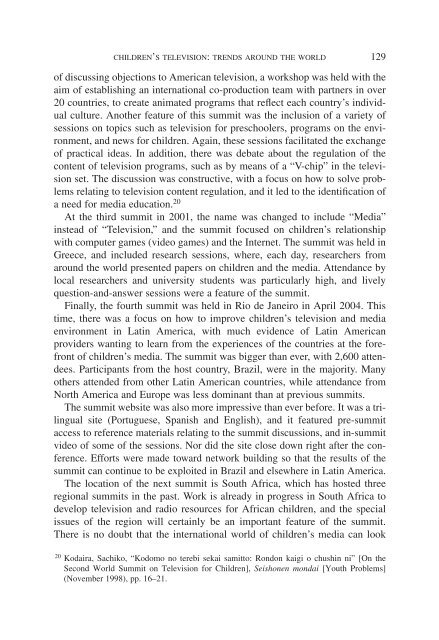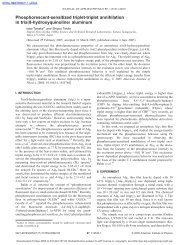Children's Television: Trends Around the World
Children's Television: Trends Around the World
Children's Television: Trends Around the World
You also want an ePaper? Increase the reach of your titles
YUMPU automatically turns print PDFs into web optimized ePapers that Google loves.
CHILDREN’S TELEVISION: TRENDS AROUND THE WORLD<br />
129<br />
of discussing objections to American television, a workshop was held with <strong>the</strong><br />
aim of establishing an international co-production team with partners in over<br />
20 countries, to create animated programs that reflect each country’s individual<br />
culture. Ano<strong>the</strong>r feature of this summit was <strong>the</strong> inclusion of a variety of<br />
sessions on topics such as television for preschoolers, programs on <strong>the</strong> environment,<br />
and news for children. Again, <strong>the</strong>se sessions facilitated <strong>the</strong> exchange<br />
of practical ideas. In addition, <strong>the</strong>re was debate about <strong>the</strong> regulation of <strong>the</strong><br />
content of television programs, such as by means of a “V-chip” in <strong>the</strong> television<br />
set. The discussion was constructive, with a focus on how to solve problems<br />
relating to television content regulation, and it led to <strong>the</strong> identification of<br />
a need for media education. 20<br />
At <strong>the</strong> third summit in 2001, <strong>the</strong> name was changed to include “Media”<br />
instead of “<strong>Television</strong>,” and <strong>the</strong> summit focused on children’s relationship<br />
with computer games (video games) and <strong>the</strong> Internet. The summit was held in<br />
Greece, and included research sessions, where, each day, researchers from<br />
around <strong>the</strong> world presented papers on children and <strong>the</strong> media. Attendance by<br />
local researchers and university students was particularly high, and lively<br />
question-and-answer sessions were a feature of <strong>the</strong> summit.<br />
Finally, <strong>the</strong> fourth summit was held in Rio de Janeiro in April 2004. This<br />
time, <strong>the</strong>re was a focus on how to improve children’s television and media<br />
environment in Latin America, with much evidence of Latin American<br />
providers wanting to learn from <strong>the</strong> experiences of <strong>the</strong> countries at <strong>the</strong> forefront<br />
of children’s media. The summit was bigger than ever, with 2,600 attendees.<br />
Participants from <strong>the</strong> host country, Brazil, were in <strong>the</strong> majority. Many<br />
o<strong>the</strong>rs attended from o<strong>the</strong>r Latin American countries, while attendance from<br />
North America and Europe was less dominant than at previous summits.<br />
The summit website was also more impressive than ever before. It was a trilingual<br />
site (Portuguese, Spanish and English), and it featured pre-summit<br />
access to reference materials relating to <strong>the</strong> summit discussions, and in-summit<br />
video of some of <strong>the</strong> sessions. Nor did <strong>the</strong> site close down right after <strong>the</strong> conference.<br />
Efforts were made toward network building so that <strong>the</strong> results of <strong>the</strong><br />
summit can continue to be exploited in Brazil and elsewhere in Latin America.<br />
The location of <strong>the</strong> next summit is South Africa, which has hosted three<br />
regional summits in <strong>the</strong> past. Work is already in progress in South Africa to<br />
develop television and radio resources for African children, and <strong>the</strong> special<br />
issues of <strong>the</strong> region will certainly be an important feature of <strong>the</strong> summit.<br />
There is no doubt that <strong>the</strong> international world of children’s media can look<br />
20 Kodaira, Sachiko, “Kodomo no terebi sekai samitto: Rondon kaigi o chushin ni” [On <strong>the</strong><br />
Second <strong>World</strong> Summit on <strong>Television</strong> for Children], Seishonen mondai [Youth Problems]<br />
(November 1998), pp. 16–21.







